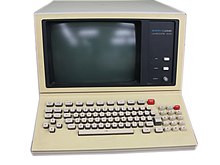Terminal (computer)

A terminal , also known as the console of a computer or, traditionally in German usage, as a data display device , is a terminal device for entering and displaying data.
Terminals are designed to formerly of mainframe computers used teletype to replace. The abbreviation tty of the English word for teletype "teletype" is still ubiquitous today in Unix operating systems and corresponding software .
While devices comparable to teleprinters - referred to as "hardcopy terminals" consisting of a printer and a keyboard - were still in use in the early days , the advantage of terminals later was that a screen was used to display the data. It could and can not only output lines sequentially; the cursor is freely maneuverable, allowing text to be scrolled and changed.
The spread of personal computers , which gradually began around 1977, has meanwhile displaced terminals from most offices. Many terminals have been replaced by terminal emulations that run on a PC. However, terminals are still widespread in some areas today.
history
As a preliminary stage and terminal-like user interface, the Zuse Z3, introduced in 1941, had a keyboard with a lamp field for inputting and outputting numbers. In the 1960s, teleprinters such as the ASR-33 and Friden Flexowriter were used as user interfaces that were locally separated from the actual computer . In 1969, the sale of the Datapoint 3300 , which was provided with a screen, was to replace the teleprinter and was called glass TTY or glass teletype , i.e. glass teleprinter (glass for screen).
links
For the connection between the terminal and the computer, there was on the one hand the serial interface (derived from the teleprinter) in the two variants as an RS-232 interface (standardized in EIA RS-232 or CCITT V.24) or, above all, in industrial applications as a 20- mA interface which was standardized as DIN 66258 and which had established itself as the de facto standard in part of the market . Other manufacturers, including the market leader IBM , used proprietary interfaces.
Originally, terminals were always connected directly to the computer, which had to be equipped with a corresponding number of interfaces. Later there were various solutions to connect several terminals via a common line, which was economically necessary, especially in the case of remote offices. IBM was able to connect terminals on the basis of a proprietary protocol within the Systems Network Architecture , DEC used DDCMP for this .
The standardized X.25 protocol was also used at greater distances .
With the introduction of local networks , e.g. on the basis of Ethernet , there were further connection options for terminals, of which ultimately only those that use the Internet protocol have prevailed. With the introduction of the Internet , a standardized connection of local and remote terminals has become possible.
Executions
Terminals are usually simple computer systems for input and output that are equipped with a special range of functions that are tailored to their respective purpose.
A distinction is made between text and graphics terminals. The former can only represent the characters and letters of a certain character set (often ASCII ), which are arranged in a matrix of mostly 80 columns (as many as punch cards had) and 24 or 25 lines.
The significantly more complex graphics terminals were primarily developed by Tektronix . They were the forerunner of the pixel-oriented hardware used today . However, in contrast to today, there were also vector-oriented terminals in which the electron beam in the cathode ray tube was freely programmable. The image was not read from a memory (today: graphics card ), which was very expensive, and transferred to the screen line by line and pixel by pixel, but the lines were written directly onto the phosphor layer, with only the coordinates of the Lines were to be held up. Storage picture tubes were mostly used for this.
In practical usage today, almost all data terminals on which users can enter anything are referred to as terminals, as the list of examples below also shows. A pseudo terminal is a virtual computer terminal in Unix or Linux systems for the input and output of data, which enables one program to control another program as if it were a user. On computers with the Mac OS operating system, the console is also called a terminal.
Examples of terminals:
- virtual terminals as text consoles for Unix computers
- ASCII terminals such as VT100 from DEC or ADM-3A from Lear Siegler
- IBM 3270 terminals
- IBM 5250 terminals for access to IBM iSeries or IBM AS / 400
- X terminal
- Btx terminals
Industry-specific terminals:
- Self-service terminals
- Electronic cash terminals
- POS terminals
- Terminals for production data acquisition
See also
- Command line
- Thin client
- Terminal server
- Satellite terminal (satellite technology)
- Internet terminal
Web links
Individual evidence
- ↑ Lippe, Prof. Dr. Tungsten. "Chapter 14 - The First Programmable Calculators
